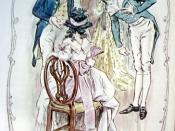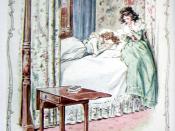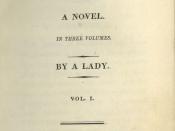In Jane Austen's first published novel, Sense and Sensibility, the story centers on the sisters Elinor and Marianne Dashwood. The sisters are forced to leave their home, and along with their mother and younger sister, they move, in reduced circumstances, to the west of England. Elinor, the "sense" of the pair, and Marianne, the "sensibility", or the romantic, of the story, must rely upon "good" marriages as means of support for the future. As their plans for marriage are interrupted by various tribulations and misunderstandings, Jane Austen explores the customs of her society and the role of marriage during the early nineteenth century.
The nineteenth century saw a great surge of events in history and politics: as Tony Tanner explains, "[Austen] saw- or lived through- the French Revolution, the rise (and fall) of Napoleon Bonaparte, the American War for Independence (and the war with England of 1812)" (Tanner, 1986, p2).
He continues to explain that Jane Austen had lived through much of the turmoil, which accompanied what E.P. Thompson has described as "the Making of the English Working Class" (1780-1832 in Thompson's version) (Thompson, 1968). She must also have been aware of the Jacobin and anti-Jacobin struggle in England, and her death fell midway between Waterloo (1815) and Peterloo (1819) (Tanner, 1986).
However, to look for obvious evidence of these events in her work would be in vain; Jane Austen has often been criticized for the small scope of her literary landscape. (Bender, 1997) A list of what Jane Austen "left out", or didn't write about, is easily drafted. That, however, is not to say her literary garden was lacking in species to choose from; Jane Austen capitalized on the vast amount of issues fostered by the upper middle class; that class, of which Austen herself was a part,


